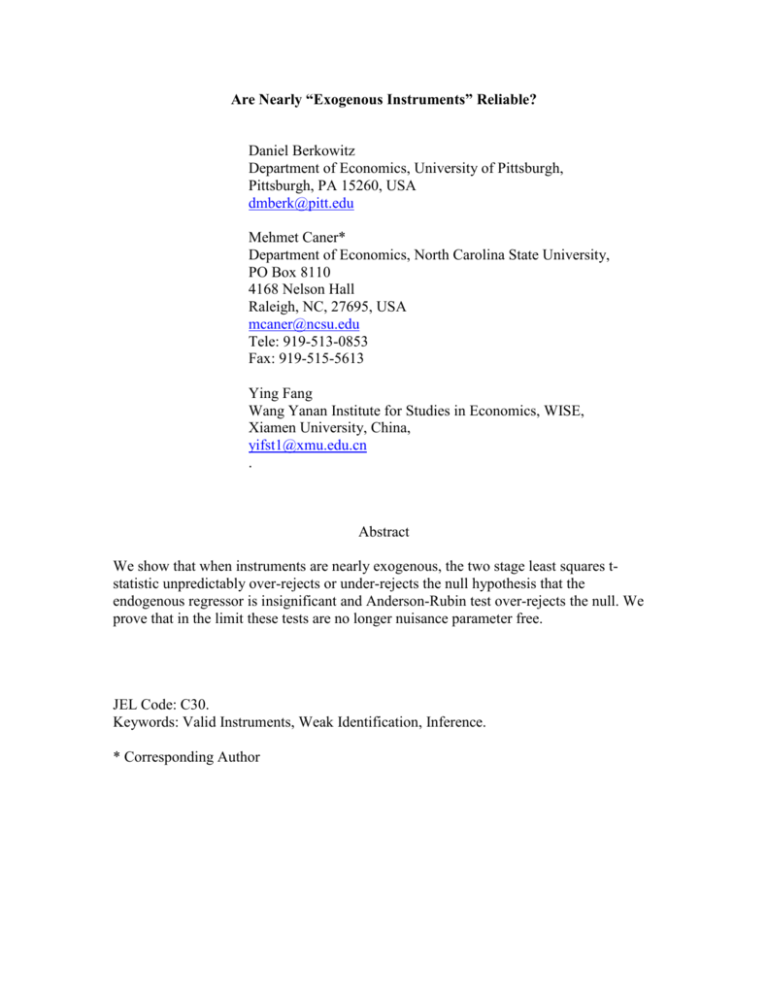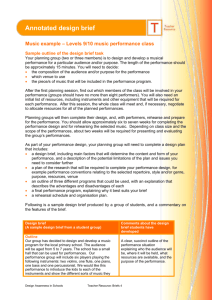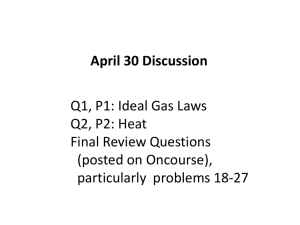Berkowitz, Caner and Fang
advertisement

Are Nearly “Exogenous Instruments” Reliable?
Daniel Berkowitz
Department of Economics, University of Pittsburgh,
Pittsburgh, PA 15260, USA
dmberk@pitt.edu
Mehmet Caner*
Department of Economics, North Carolina State University,
PO Box 8110
4168 Nelson Hall
Raleigh, NC, 27695, USA
mcaner@ncsu.edu
Tele: 919-513-0853
Fax: 919-515-5613
Ying Fang
Wang Yanan Institute for Studies in Economics, WISE,
Xiamen University, China,
yifst1@xmu.edu.cn
.
Abstract
We show that when instruments are nearly exogenous, the two stage least squares tstatistic unpredictably over-rejects or under-rejects the null hypothesis that the
endogenous regressor is insignificant and Anderson-Rubin test over-rejects the null. We
prove that in the limit these tests are no longer nuisance parameter free.
JEL Code: C30.
Keywords: Valid Instruments, Weak Identification, Inference.
* Corresponding Author
I. Introduction
Instrumental variable methods are used to identify causal relationships.
Researchers pick relevant instruments that should be related to the endogenous
explanatory variable both on the basis of a priori argument and statistically.1
Instruments must also be exogenous; that is, they are not related to the outcome
variable after controlling for relevant explanatory variables. Just whether or not the
exclusion restriction is satisfied is controversial for many other seemingly exogenous
instruments. For example, Angrist (1990) argues that draft lottery numbers are
instruments for testing whether serving in Vietnam affects the earnings of men in the
civilian sector because these numbers influence earnings purely through military service.
However, Wooldridge (2002, p.88) argues that because civilian employers are more
likely to invest in job training for employees who have high draft numbers, these
numbers could also influence earnings through job training, which is unobservable.
We show that the standard t-test statistic is unreliable: even when the instrument
is very close to being exogenous, the t-test grossly and unpredictably over-rejects or
under-rejects the null that the endogenous regressor is insignificant, and the AndersonRubin test over-rejects the null. We prove these results in the limit and in small samples.
And, to our knowledge, these are new theoretical results.
2. Inference Using the Standard Test Statistics
In this section we relax the assumption that instruments must be exogenous and
introduce a definition of “near exogeneity.” Suppose we want to check for whether not
an institution, say property rights enforcement, influences long term growth in a sample
of countries.2 If we suspect that institutions are endogenous and we also believe that a
linear specification is appropriate, we would estimate and compute test-statistics for the
following simple linear simultaneous equations model (Hausman, 1983; Phillips, 1983):
LRGr 0 1 INST u
(1)
INST 0 Z 1 V
(2)
Equation (1) is the structural equation, where LRGr is an nx1 vector of long run growth,
INST is an nx1 vector of institutions, and u is an nx1 vector of structural error terms that
have zero mean and finite variance u2 . Equation (2) is the reduced form, Z is an
nxk matrix of instruments and V is an nx1 vector of reduced form errors that have zero
1
Instruments that marginally satisfy this requirement are denoted weak and are the
subject of a large and growing literature (see Staiger and Stock, 1997; Stock et al, 2000).
2
We just consider one kind of institution and, hence, one endogenous variable for
expositional simplicity. Our method also works for multiple endogenous variables. See
Acemoglu and Johnson (2006) for an analysis of how instrumental variables can be used
to identify how two endogenous institutions, property rights (measured by a survey of
risk of expropriation) and efficiency of contracts (measured by an index of legal
formalism), can affect long run growth.
1
means and finite variance. V2 . The error terms u and V may be correlated and n
represents the number of countries. The parameters 0 , 1 , 0 and 1 , are unknowns,
and, for notational conventional, we denote { 0 , 1 } , { 0 , 1 } . Other
covariates, for example, population, latitude and education, can be added to the system in
equations (1) and (2) without loss of generality.3
In order to determine whether or not institutions matter, we estimate the unknown
parameter β1 and use test-statistics to check whether β1 = 0. To do this properly, we need
valid instruments that are both relevant and exogenous. As previously discussed, relevant
instruments are picked on the basis of a theoretical, institutional and/or historical
argument, and are validated ex post by estimating the reduced form. The second criterion
for validity is that instruments are exogenous, which implies they are orthogonal to the
error term in the structural equation:
Exogenous Cov Z i' ui 0
(3)
It is generally difficult, as we have previously argued, to find instruments that
satisfy this strong condition. In particular, while these instruments influence long run
growth in the structural equation primarily through institutions, they may also be weakly
correlated with unobserved factors that can also influence long term growth. We model
this potential small correlation as “nearly exogenous” which is a local to zero setup:
(4)
Nearly Exogenous Cov Z i' ui C / n
where C is an nx1 vector of constants that is contained in compact set.
If we choose Cov Z i' ui C to capture near exogeneity, then the test statistics
always diverge in the limit. Thus, this assumption does not provide any guidance for
finite sample behavior when there is some mild correlation between the instrument and
error.
In what follows, small sample simulation methods are used to show that even a
slight relaxation of the exogeneity assumption in equation (3) makes the standard test
statistics unreliable. Suppose we employ the TSLS t-test to determine whether or not
institutions matter. Denoting the H0 and H1 as the null and the alternative and 1,TSLS as
the TSLS estimator of 1 , we use the t-statistic to test
H 0 : 1 0 , against
H1 : 1 0 , where the t-statistic is given by
t 1,TSLS /
a var 1,TSLS
(5)
3
By the Frisch-Waugh-Lovell Theorem, we can always project out these covariates and
obtain the system in equations (1) and (2) (see Davidson and McKinnnon, 1993, p.19).
2
We generate i.i.d. data for the one instrument, the structural error term and
reduced form, (Z,u,V), from a joint normal distribution N(0, Λ) and
1
Cov Zi ui
0
Cov Zi ui
1
CovVi ui
Cov Vi ui .
1
0
(6)
where Cov Zi’ui measures the correlation between the instrument Z and the error term u,
and Cov Vi’ui measures the endogeneity of institutions, which is set to 0.25 in all
simulations. When the iid data (Z,u,V) are generated, we can derive the observation of
and INST and LRGr by using equations (1) and (2) and specified true values of
1 and 1 . Based on the information of (LRGr, INST, Z), we compute the t-statistic and
then test whether the null of β1= 0 can be rejected at the 5% level by using the critical
value 1.95. We replicate the simulation by 1000 times to derive the distribution of the tstatistic and calculate the actual rejection probability which is reported in Table 1.
Table 1 reports rates of right hand side and left hand false rejection when the
instrument is more weakly correlated with the error term: Cov Zi’ui = 0.06 or -0.06 and
illustrates that as the absolute value of the correlation decreases, the size problems of the
two-sided t-test are mitigated. When the correlation is positive there is a 9.4% false
rejection rate on the right hand side, a conservative 0.4% rate from the left hand side and
an overall 9.8% false rejection rate. When, the correlation is negative, the rates of false
rejection on the right hand and left hand sides are 0.6% and 7.2%, respectively, and the
overall false rejection rate is 7.9%.
Suppose we test the null against the alternative using Anderson-Rubin (Anderson
and Rubin, 1949) test:
AR (1 0) LRGr ' Pz LRGr / ( LRGr ' M z LRGr ) /( n 2)
(7)4
Here, AR (1 0) is the test statistic for the null, Pz Z ( Z ' Z ) 1 Z is the projection matrix
and M z I Pz .
.
Table 1 illustrates that the small sample problems associated with the AndersonRubin test (for herein, denoted the AR-test) are also diminished when the instrument is
less endogenous. When the correlation decreases to 0.06, the AR-test falsely rejects 9.4%
of the time. Since it is not possible to calculate the absolute value of the correlation
between the instruments and structural error, it is not possible to adjust for this small
sample distortion and the AR-test is also unreliable.
4
We can generalize this test statistic to allow for multiple endogenous explanatory
variables and as least as many instruments.
3
3. Large Sample Distributions
This section adds to the bad news: we show that the shifts in test statistic
distributions observed in the small sample simulations also hold in limit. For the next
three sections of the paper, we generalize the simultaneous equations system equations
(1) and (2) to model a more general system with m ≥ 1 endogenous explanatory variables,
and k ≥ m instruments:
y Y u
(1*)
Y Z V
( 2*)
where y and Y are respectively and nx1 vector and nxm matrix of endogenous
explanatory variables, Z is an nxk matrix of instruments, u is an nx1 vector of structural
errors, V is an nxm matrix of reduced form errors, and the errors have zero means and
finite variance, and u and V are correlated with each other. As noted before, other
exogenous covariates can be added to the system.
In the next theorem, we show that near exogeneity shifts the asymptotic
distribution of the t-statistic to a normal distribution with non-zero mean.
Theorem 1: Suppose that the instrument is nearly exogenous according to (4), and the
standard Assumption 2 in the appendix holds. Then,
d
t N [ u1 ( ' Q zz ) 1 / 2 ' C , 1]
(8)
where u is the square root of u2 , and Qzz is the second moment matrix of
instruments.
Proof. See the Appendix.
According to Theorem 1, the mean of the distribution depends upon the parameter
C, which, by equation (4), is related to the small correlation between structural error and
instruments. When C=0 and the instruments are exogenous, the t-statistic converges to
the standard normal distribution. When C>0 (given 0 ), the distribution shifts to the
right. When C<0 (given 0 ), the distribution shifts to the left. Since we cannot
consistently estimate C let alone know its sign, we cannot use this large sample theorem
to improve inference.
The next theorem characterizes the impact of near exogeneity on the distribution
of the AR-test, which is now more generally defined from equation (7) for k instruments
and m endogenous explanatory variables:
AR ( 0 ) ( y Y 0 )' Pz ( y Y 0 ) / ( y Y 0 )' M z ( y Y0 ) /( n k m)
(7*)
We use this statistic to test H 0 : 0 against H 1 : 0 where 0 is the true value.
Theorem 2: Suppose that the instrument is nearly exogenous according to (4), and the
standard Assumption 2 in the appendix holds. If the null hypothesis is 0 , then
4
d
AR ( 0 ) K2 ( )
(9)
where K2 ( ) is a non-central chi-square distribution with k degrees of freedom and the
non-centrality parameter C ' 1 C , where u2 Q zz .
Proof. See the Appendix.
According to Theorem 2, the mean of the non-centrality parameter is quadratic in
parameter C. Therefore, when C=0 the AR-test converges to the centered chi-square
distribution, and when C≠0 the distribution shifts to the right. Again, since we do not
know C, we cannot use these theorems to obtain appropriate critical values. The
convergence is uniform.
4. Conclusion
This article analyzes the limit theory when there are both weakly identified as well as
nearly exogenous instruments. We show that Anderson-Rubin test is no longer
asymptotically pivotal. In future research we consider how to remedy this problem by
using a delete-d jackknife bootstrap procedure.
Appendix
In the beginning of this appendix, we first describe the near exogeneity
assumption and some moment conditions that are required to obtain the theorems in the
paper. Assumptions 1 and 2 are sufficient for Lemma 1, Theorem 1 and Theorem 2.
Assumption 1: Near Exogeneity E Z i ui C / N , where C is a fixed K 1
vector.
Assumption 2: The following limits hold jointly when the sample size N
converges to infinity:
p
(a) (u u / N ,V u / N ,V V / N ) ( u2 , Vu , VV ) , where u2 , Vu and VV are
respectively a 1 1 scalar, an m 1 vector and an m m matrix.
p
(b) Z Z / N QZZ where QZZ is a positive definite, finite K K matrix.
d
(c) ( Z ' u / N , Z 'V / N ) ( Zu , ZV )
Zu
C
N , Q zz
0
ZV
2
Vu
.
where u
VV
Vu
5
, and
These convergences in Assumption 2 are not primitive assumptions but hold
under weak primitive conditions. Parts (a) and (b) follow from the weak law of large
numbers, and Part (c) follows from triangular arrays central limit theorem. Instead of a
mean zero normal distribution in Staiger and Stock (1997), the Zu in (c) is a normal
distribution with nonzero mean, which is a drift term C coming from the near exogeneity
2
for some
assumption. For any independent sequence Z i u i , if E Z i u i
0 for all i 1, 2, 3,..., N , then Liapunov's theorem leads to the limiting results in
(c); see James Davidson (1994).
Lemma 1. If Assumptions 1 and 2 hold for the model defined by (1*) and (2*), then
the TSLS estimator TSLS is consistent and
d
N ( TSLS 0 ) N (( QZZ ) 1 C , u2 ( QZZ ) 1 )
p
p
where u u / N E (u i2 ) u2 , Z Z / N E ( Z i Z i ) QZZ .
Proof of Lemma 1: We know that
TSLS (Y PZ Y ) 1 (Y PZ y ).
So we have
N ( TSLS 0 )
Y Z Z Z 1 Z Y 1 Y Z Z Z 1 Z u
[(
)(
) (
)] [(
)(
) (
)]
N
N
N
N
N
N
By Assumption 2 and equation (2*), we can obtain that
Y Z Z Z 1 Z Y 1
[(
)(
) (
)]
N
N
N
p
(QZZ ) 1
Now, we consider
Z u
1 N
1 N
[ Z iui E ( Z iui )]
E ( Z iui )
N
N i 1
N i 1
Combining Assumptions (1) and (2), we obtain
Z u d
N [C , u2QZZ ] .
N
Then the result in the lemma follows directly.
Q.E.D.
Lemma 1 summarizes the limiting results of the TSLS estimator under near
exogeneity. The reason why we can obtain a consistent estimator under near exogeneity
is because the correlation between instruments and structural errors shrinks toward zero
asymptotically. When C=0, we can obtain the regular results of the TSLS estimator under
the orthogonality condition. Instead of a normal distribution with a zero mean, near
exogeneity can shift the distribution away from mean zero. The nonzero mean depends
on an unknown local to zero parameter C which is impossible to be estimated
consistently (Donald W.K. Andrews, 2000).
6
Proof of Theorem 1: The result in the theorem directly follows from Lemma 1.
Q.E.D.
Proof of Theorem 2: The Anderson-Rubin test is given by
1
AR( 0 ) ( y Y 0 )PZ ( y Y 0 ) /
( y Y 0 )M Z ( y Y 0 )
N K
We first observe that
( y Y0 )PZ ( y Y0 ) uPZ u.
Define PZ1 / 2u . Parts (b) and (c) in Assumption 2 implies:
d
1 / 2
1 / 2
QZZ
Zu N (QZZ
C , u2 ).
Next, note that
1
( y Y 0 )M Z ( y Y 0 )
N K
1
uM Z u
N K
1
1
uu
uPZ u
N K
N K
By part (a) in Assumption 2, the first term converges in probability to u2 , and the last
term tends to zero. We have
p
1
( y Y 0 )M Z ( y 0 ) u2 .
N K
So
d
AR( 0 ) K2 (C 1C ), where
u2Q ZZ Q.E.D.
7
References
Acemoglu, D. and S. Johnson, 2006, Unbundling Institutions, Journal of Political
Economy 113, 949-995.
Anderson, T.W. and H. Rubin, 1949, Estimators of the Parameters of
a Single Equation in a Complete Set of Stochastic Equations, The Annals of
Mathematical Statistics 20, 46-63.
Andrews, D. W.K. 2000, Inconsistency of the Bootstrap with a Parameter Is on
the Boundary of the Parameter Space, Econometrica 68, 399-405.
Angrist, J. D. 1990, Lifetime Earnings and the Vietnam Era Draft Lottery: Evidence from
Social Security Administrative Records, American Economic Review 80, 313-336.
Davidson, J. 1994, Stochastic Limit Theory: An Introduction for Econometricians,
(Oxford University Press, Cambridge).
Davidson, R.. and J. G. McKinnnon 1993, Estimation and Inference in Econometrics,
(Oxford University Press, New York).
Hausman, J. A. 1983, Specification and Estimation of Simultaneous Equations
Models, in: Zvi Grilliches and Michael D. Intrilligator, eds., Handbook of Econometrics,
Volume 1 (Amsterdam, North Holland) Chapter 7.
Phillips, P. C.B. 1983, Exact Small Sample Theory in the Simultaneous Equations Model,
in: Zvi Grilliches and Michael D. Intrilligator, eds., Handbook of Econometrics, Volume
1 (Amsterdam, North Holland) Chapter 8.
Staiger, D. and J. H. Stock, 1997, Instrumental Variables Regression with
Weak Instruments, Econometrica, 65, 557-586.
Stock, J. H., J. H. Wright, and M. Yogo 2002, A Survey of Weak
Instruments and Weak Identification in Generalized Method of Moments, Journal of
Business and Economic Statistics, 20, 518-529.
Wooldridge, J. M. 2002, Econometric Analysis of Cross Section and Panel Data. (MIT
Press, London and Cambridge).
8
Teststatistic
t-statistic
t-statistic
AR test
t-statistic
t-statistic
AR test
Table 1: Test Statistics
Sample Size = 100, and 1,000 simulations
Truth is that Institutions Do Not Matter
Nominal
Cov Zi’ui
Actual
Actual
5% Critical
rejection rejection
Values
rate
rate (RHS)
±1.95
0.06
9.8%
9.4%
±1.95
-0.06
7.9%
0.6%
3.85
±0.06
9.4%
n.a.
±1.95
0.10
19.4%
19.2%
±1.95
-0.10
14.3%
0.3%
3.85
±0.10
17.7%
n.a.
9
Actual
rejection
rate (LHS)
0.4%
7.2%
n.a.
0.2%
14.0%
n.a.









